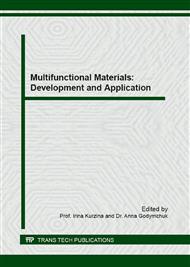[1]
T.R. Sippel, S.F. Son, L.J. Groven, S. Zhang, E.L. Dreizin, Exploring mechanisms for agglomerate reduction in composite solid propellants with polyethylene inclusion modified aluminum, Combust. Flame. 162 (2015) 846-854.
DOI: 10.1016/j.combustflame.2014.08.013
Google Scholar
[2]
T. Naya, M. Kohga, Thermal decomposition behaviors and burning characteristics of AN/nitramine-based composite propellant, J. Energ. Mater. 33 (2015) 73-90.
DOI: 10.1080/07370652.2014.902406
Google Scholar
[3]
A.V. Khaneft, V.A. Dolgachev, Simulation of initiation of PETN by a nanosecond laser pulse in the weak absorption region, Combust. Explo. Shock+. 50 (2014) 105-112.
DOI: 10.1134/s0010508214010134
Google Scholar
[4]
P.A. Kakavas, Mechanical properties of propellant composite materials reinforced with ammonium perchlorate particles, Int. J. Solids Struct. 51 (2014) 2019-(2026).
DOI: 10.1016/j.ijsolstr.2014.02.015
Google Scholar
[5]
D.O. Glushkov, G.V. Kuznetsov, P.A. Strizhak, Numerical study of ignition of a metallized condensed substance by a source embedded into the subsurface layer, Russ. J. Phys. Chem. B+. 7 (2013) 269-275.
DOI: 10.1134/s1990793113050059
Google Scholar
[6]
D. Ogunkoya, W.L. Roberts, T. Fang, N. Thapaliya, Investigation of the effects of renewable diesel fuels on engine performance, combustion, and emissions, Fuel. 140 (2015) 541-554.
DOI: 10.1016/j.fuel.2014.09.061
Google Scholar
[7]
D.O. Glushkov, G.V. Kuznetsov, P.A. Strizhak, Research of macroscopic regularities of heat and mass transfer at the ignition condition of a liquid high-energy material by an immersed source with a limited energy capacity, Adv. Mech. Eng. 2014 (2014).
DOI: 10.1155/2014/764537
Google Scholar
[8]
H. Yamik, An investigation of effect of biodiesel and aviation fuel jeta-1 mixtures performance and emissions on diesel engine, Therm. Sci. 18 (2014) 239-247.
DOI: 10.2298/tsci130410007y
Google Scholar
[9]
D.O. Glushkov, G.V. Kuznetsov, P.A. Strizhak, Numerical and experimental research of heat and mass transfer at the heterogeneous system ignition by local energy source with limited heat content, Math. Prob. Eng. 2014 (2014), Article ID 281527.
DOI: 10.1155/2014/281527
Google Scholar
[10]
A. Matthujak, K. Pianthong, K. Takayama, B.E. Milton, Experimental study of ignition over impact-driven supersonic liquid fuel jet, Adv. Mech. Eng. 2013 (2013), Article ID 928970.
DOI: 10.1155/2013/928970
Google Scholar
[11]
F. Ansari, F. Soofivand, M. Salavati-Niasari, Utilizing maleic acid as a novel fuel for synthesis of PbFe12O19 nanoceramics via sol-gel auto-combustion route, Mater. Charact. 103 (2015), Article ID 7835.
DOI: 10.1016/j.matchar.2015.03.010
Google Scholar
[12]
H. Wang, H. Huang, J. Liu, Preparation of UO2/TiO2 composite ceramic fuel by sol gel-press forming method, Ceram. Int. 40 (2014) 5671-5674.
DOI: 10.1016/j.ceramint.2013.11.004
Google Scholar
[13]
G.V. Kuznetsov, P.A. Strizhak, Computational investigation of heat and mass transfer processes in a gel-like fuel ignited by a limited-capacity source, J. Eng. Ph. Thermophys. 86 (2013) 695-704.
DOI: 10.1007/s10891-013-0885-0
Google Scholar
[14]
V.V. Burkin, R.S. Burkina, Initiation of a charge of a gel-like reactive substance by an electric explosion. Part 2. Hydrodynamic processes, Combust. Explo. Shock+. 38 (2002) 201-205.
Google Scholar
[15]
V.N. Vilyunov, V.E. Zarko, Ignition of Solids, Elsevier, Amsterdam, (1989).
Google Scholar
[16]
P.J. Roache, Computational Fluid Dynamics, Hermosa Publishers, Albuquerque, (1976).
Google Scholar
[17]
D.A. Frank-Kamenetsky, Diffusion and Heat Transfer in Chemical Kinetics, Plenum, New York, (1969).
Google Scholar
[18]
F. Asllanaj, A. Milandri, G. Jeandel, J.R. Roche, A finite difference solution of non-linear systems of radiative-conductive heat transfer equations, Int. J. Numer. Methods Eng. 54 (2002) 1649-1668.
DOI: 10.1002/nme.490
Google Scholar


